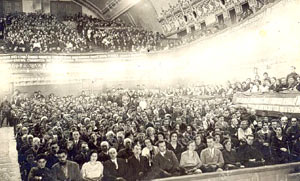Home page
» BALLET
» About Ballet
About Ballet Ballet History Usually, a plot of the ballet is based on the dramaturgic idea, but there is a plotless ballets, too. As usual the classical and character dances are used in ballet. However, pantomime plays an important role in this type of art. Actors deliver feelings of heroes, whatever happens on stage with the help of the pantomime. Elements of gymnastics and acrobatics are widely used in modern ballet as well. Ballet emerged as a part of the musical performances – operas, as a small dance episodes in Italy during the Renaissance (XVI century). The first ballet performance which combine music, speech, dance and pantomime Jirjeia or Queen\'s funny ballet was staged in 1581by the Italian ballet-master Baltazarini di Beljoyozo in Ekaterina Medici Palace. Since then the genre of the palace ballet have developed in France. (Masquerades, pastorals, dance divertissements and intermediacy). During XIV Ludovic ballet performances in the palace reached the high level, and scene effects that give legendary character to plays were used in the plays. In the second half of XVII century, genres like the comedy-ballet, opera-ballet appear, in which more space is allocated to ballet and the attempt to dramatize it is made. Further period of development and flourishing of the ballet coincides with the period of romanticism. In the 30-es of the XVIII century, the French ballerina Camargo shorten her skirt and refuse high-heeled shoes and brings innovations to dance. At the end of the XVIII century the ballet costume gets more lighter, and it helps a lot to the development of dance techniques. Dancers trying to perform their dance airily try to stand on the fingers of feet. As a result, it is pointe was invented. For the first time as a means of expression dancer Maria. Talyoni used pointe. There are different kinds of ballet: classical, ballet multy act, dramballet, plotless ballet - ballet, symphony, mood ballet - miniature. According to the genre of ballet is divided into the comic, folklore, and heroic ballets. In the twentieth century new forms were brought to ballet – jazz-ballet and modern-ballet.  Ballet in Azerbaijan The history of appearance of the ballet begins since 1940 with staging of Afrasiyab Badalbeyli’s Maiden Tower ballet but in fact it had the beginning from 20-es. Thus, in 1923, the private ballet studio functioned in Baku. By the way, the first ballerina of Azerbaijan Qamar Almaszade, had taught secrets of the art of ballet, in this school where majority of students were other nations. Later, the theater\'s repertoire was enriched with Gulshan (1950, S. Hajibeyov) Seven Beauties (1952, G. Qarayev), Gypsy Girl (1965, E. Abbasov), Thunder (1961, G. Garayev), Legend of Love (1962, A. Melikov), Arabian Nights (1979, F.Amirov), Babek (1986, Agshin Alizadeh), White and Black (2000, Khayyam Mirzazade), Love and Death (2005, P. Bulbuloglu) and s. works.
|
